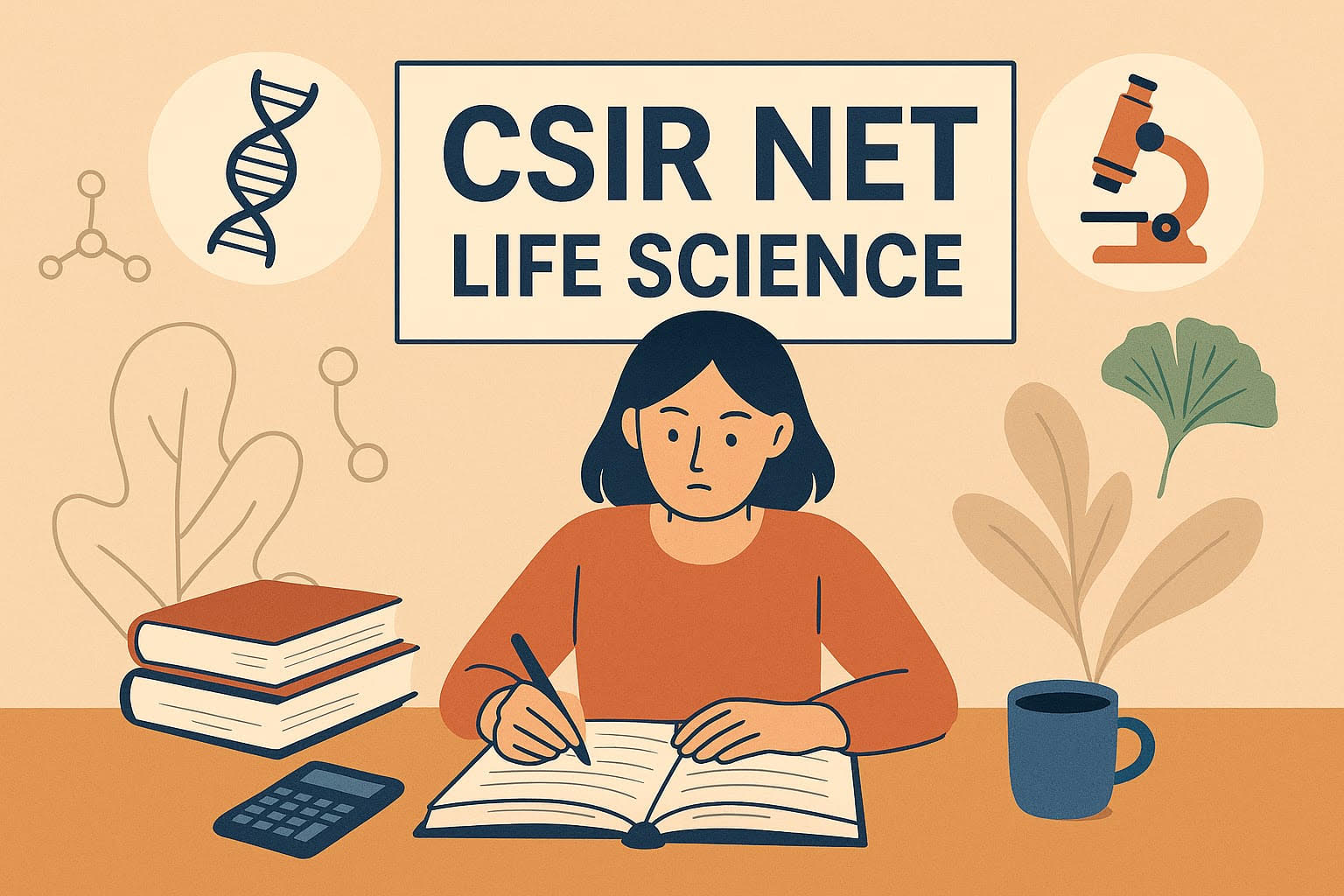
A Complete Beginner’s Guide (2026)
Introduction
The Council of Scientific and Industrial Research – National Eligibility Test (CSIR NET) in Life Sciences is one of the most prestigious competitive exams for aspirants aiming to build a career in research or academia. Clearing this exam not only opens doors for Junior Research Fellowship (JRF) and Lectureship (LS) positions but also boosts your profile in the field of biological sciences.
This beginner’s guide provides a step-by-step strategy to crack CSIR NET Life Sciences, from understanding the syllabus to mastering time management, with actionable tips and proven methosuccess
Step 1: Understand the CSIR NET Life Sciences Exam Pattern
Before jumping into preparation, you must have a clear understanding of the exam pattern.
Section Number of Questions Marks per Question Negative Marking Marks Weightage
Part A 20 (Attempt 15) 2 marks each 0.5 30
Part B 50 (Attempt 35) 2 marks each 0.5 70
Part C 75 (Attempt 25) 4 marks each 1 100
Total 145 — — 200
Key Points:
Part A tests General Aptitude (numerical ability, logical reasoning, data interpretation).
Part B covers subject-related questions of moderate difficulty.
Part C consists of analytical and application-based questions, often scenario-driven.
Step 2: Know the Complete CSIR NET Life Sciences Syllabus
The syllabus is vast, covering 13 core units:
1. Molecules and their Interaction Relevant to Biology
2. Cellular Organization
3. Fundamental Processes
4. Cell Communication and Cell Signaling
5. Developmental Biology
6. System Physiology – Plant
7. System Physiology – Animal
8. Inheritance Biology
9. Diversity of Life Forms
10. Ecological Principles
11. Evolution and Behavior
12. Applied Biology
13. Methods in Biology
Pro Tip: Instead of trying to memorize the entire syllabus, prioritize topics based on past year weightage and your strengths.
Step 3: Make a Realistic Study Plan
A study plan is essential for systematic preparation. Here’s a suggested 6-month timeline for CSIR NET Life Sciences:
Month 1–2: Foundation Building
Study basic concepts of molecular biology, biochemistry, and genetics.
Read NCERT Biology (Class XI & XII) for conceptual clarity.
Refer to standard books like Lehninger’s Principles of Biochemistry and Molecular Biology of the Cell by Alberts.
Month 3–4: Advanced Topics & Application
Dive deeper into cell signaling, physiology, developmental biology, and ecology.
Start solving Part B-level questions after finishing each topic.
Make short notes for quick revision.
Month 5: Problem-Solving Practice
Focus on Part C questions, especially from previous years.
Practice analytical and comprehension-based problems.
Attempt full-length mock tests.
Month 6: Revision & Mock Tests
Revise all topics using your short notes.
Solve at least 10 previous year papers.
Identify and work on weak areas.
Step 4: Best Books & Study Materials
Here’s a recommended list of resources for CSIR NET Life Sciences:
General Aptitude (Part A):
CSIR NET General Aptitude by Christy Varghese
Quantitative Aptitude by R.S. Aggarwal
Life Sciences (Part B & C):
Molecular Biology of the Cell – Alberts
Lehninger Principles of Biochemistry
Genetics – Benjamin Pierce
Plant Physiology – Taiz & Zeiger
Animal Physiology – Guyton & Hall
Developmental Biology – Scott F. Gilbert
Ecology – Odum
Additional Resources:
CSIR NET Life Sciences Previous Year Question Papers
NPTEL & SWAYAM online courses
GateIIT study modules & practice sets
Step 5: Subject-Wise Strategy
1. Molecules and Their Interaction
Focus on protein structure, enzyme kinetics, nucleic acid biology.
Practice numerical problems on enzyme inhibition.
2. Cellular Organization
Study organelles, cytoskeleton, and membrane transport mechanisms.
Diagrams help in quick recall.
3. Fundamental Processes
Cover DNA replication, transcription, translation.
Understand experimental evidence for each process.
4. Cell Communication
Learn signaling pathways like MAPK, JAK-STAT, GPCR.
Focus on cross-talk between pathways.
5. Developmental Biology
Understand model organisms (Drosophila, C. elegans, Arabidopsis).
Revise developmental stages and mutations affecting development.
6. Physiology (Plant & Animal)
Integrate concepts with diagrams.
Practice application-based questions.
Step 6: Practice and Analyze Previous Year Papers
Solving previous years’ papers will:
Familiarize you with question types.
Help identify high-weightage topics.
Improve time management skills.
Step 7: Time Management During the Exam
Tips:
Attempt Part A first to build momentum.
Spend a maximum of 30 minutes on Part A, 45 minutes on Part B, and the remaining on Part C.
Mark questions for review if unsure—don’t waste time on tough ones initially.
Step 8: Common Mistakes to Avoid
Skipping General Aptitude: Even Part A can fetch easy marks.
Ignoring Revision: Without revision, retention drops.
Overloading with Books: Stick to selected resources instead of hoarding material.
Not Practicing Part C Enough: Application-based questions need extra attention.
Step 9: Final 30-Day Strategy Before Exam
Week 1–2: Revise entire syllabus in short bursts.
Week 3: Take mock tests daily, analyze mistakes.
Week 4: Focus only on strong topics and high-yield areas.
Step 10: Stay Consistent & Motivated
Preparation for CSIR NET Life Sciences is a marathon, not a sprint. Surround yourself with a study group, join online classes, and keep track of your progress.
How GateIIT Institute Helps in the Preparation of CSIR NET Life Sciences
Comprehensive Syllabus Coverage – All 13 units are covered in detail with in-depth conceptual clarity.
Expert Faculty – Classes are conducted by experienced educators with years of CSIR NET mentoring experience.
Updated Study Material – Includes concise theory notes, solved examples, and practice questions tailored to the latest CSIR NET pattern.
Regular Tests & Mock Exams – Simulates real exam conditions to improve speed and accuracy.
One-on-One Doubt Clearing – Ensures no concept remains unclear.
Online + Offline Learning Options – Flexible learning for students across India.
Performance Tracking – Periodic analysis to identify weak areas and provide targeted improvement plans.
If you’re serious about cracking CSIR NET Life Sciences 2026, enrolling in a structured and guided program like GateIIT’s can significantly increase your chances of success.
Source link



